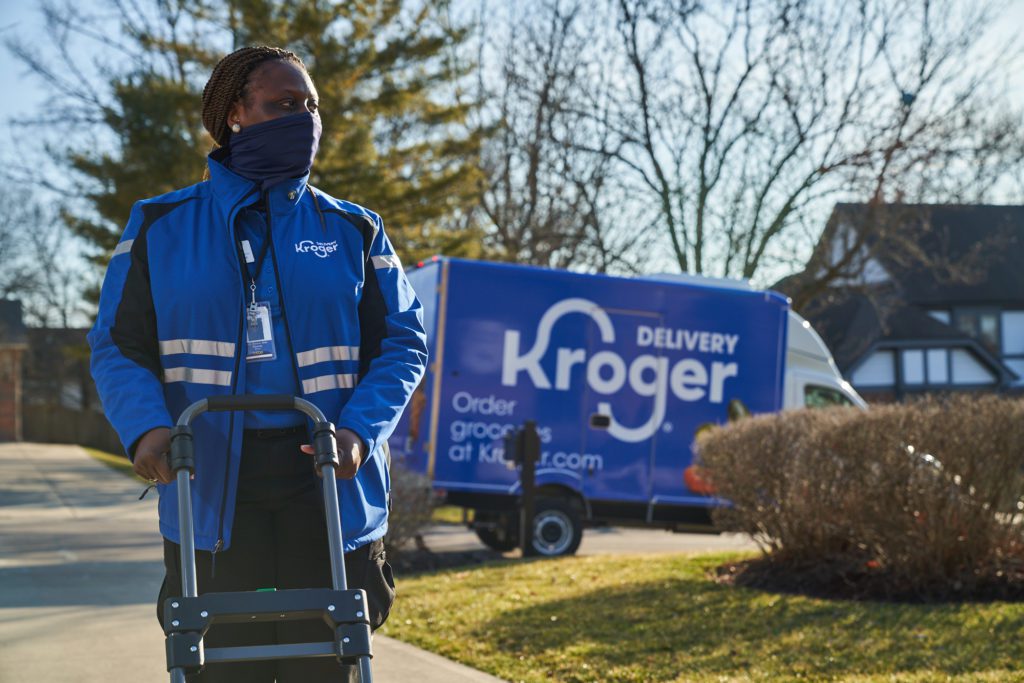At the start of the COVID-19 pandemic, many consumers feared entering stores and migrated to grocery shopping online. The Kroger Co., however, was primed and ready for the boost in online grocery shopping, thanks to its earlier work with technology vendor Ocado Group PLC in building robotic fulfillment centers.
Kroger’s goal is to build 20 “Ocado-powered” ecommerce fulfillment centers in the United States, meaning each fulfillment center will use Ocado’s robotic warehouse technology. The grocery giant already had the foundation in place for this plan, as Kroger bought a stake in Ocado in May 2018 to use the British grocer’s automated warehouse, designed to fulfill online orders for delivery to consumers’ doors. The deal was Ocado’s first in the U.S. Under the terms of the agreement, Kroger became Ocado’s exclusive U.S. partner.
Kroger continues to move ahead with plans to build automated ecommerce fulfillment centers across the 35 states it serves. The grocery retailer and technology vendor plan to build centers in the West, Pacific Northwest and Great Lakes regions of the United States.
Kroger in April 2021 opened its first one—a 375,000-square-foot fulfillment center in Monroe, Ohio—that uses artificial intelligence, robotics and automation.
“2020 was a pivotal year for grocery ecommerce,” said Rodney McMullen, Kroger’s chairman and CEO in an earnings call.
“The momentum we’re experiencing is well-timed with the evolution of Kroger Delivery, underpinning the permanent shift in grocery consumer behavior and need for enterprising and modern ecommerce and last-mile solutions—today’s true competitive horsepower,” McMullen said. The grocery retailer’s online business reached more than $10 billion and posted a record online sales increase of 116% in 2020, he said.
Inside the customer fulfillment center, more than 1,000 robots move around giant 3-D grids, the retailer said. The grid, known as The Hive, contains totes with products for customer orders.
When a customer places an order on Kroger.com or through the Kroger app, the bots retrieve products from The Hive. They then move to pick stations and sort items for delivery. Kroger has developed a sorting algorithm that ensures items are packed to prevent damage and save space. For example, the system places fragile items on top, ensures the bags have similar weights and that each order uses the least number of bags possible.
After packing, customers’ orders are loaded into a temperature-controlled Kroger van for delivery. The vans can store up to 20 orders at once. “Powerful machine-learning algorithms dynamically optimize delivery routes, considering factors like road conditions and optimal fuel efficiency,” Kroger said.

The robots and automation allow Kroger to fulfill thousands of orders per day from its Ohio warehouse. But the fulfillment center still uses humans to deliver orders and to help process, package and load orders. Once fully staffed, the Ohio facility plans to employ about 400 associates for customer service, engineering, operations, inventory, quality management and transportation.
Kroger says it will continue to leverage stores and third-party partners like Instacart to deliver orders until it builds out more automated fulfillment centers. As of the end of its fiscal 2020, Kroger had 2,223 pickup sites and 2,472 stores that can deliver online orders, covering 98% of the households in its market areas.
“We’re excited to be building a distribution network that creates a more equitable food system by providing greater accessibility to fresh food through the power of innovation,” said Gabriel Arreaga, Kroger’s senior vice president and chief supply chain officer. “Kroger Delivery’s network of customer fulfillment centers will accelerate our ecommerce capabilities, focusing on more cost-effective supply chain and last-mile delivery solutions, seamless customer experiences and new career opportunities.”
Kroger is No. 8 in the 2021 Digital Commerce 360 Top 1000. Ocado is No. 23 in the Digital Commerce 360 Europe 500.
Favorite